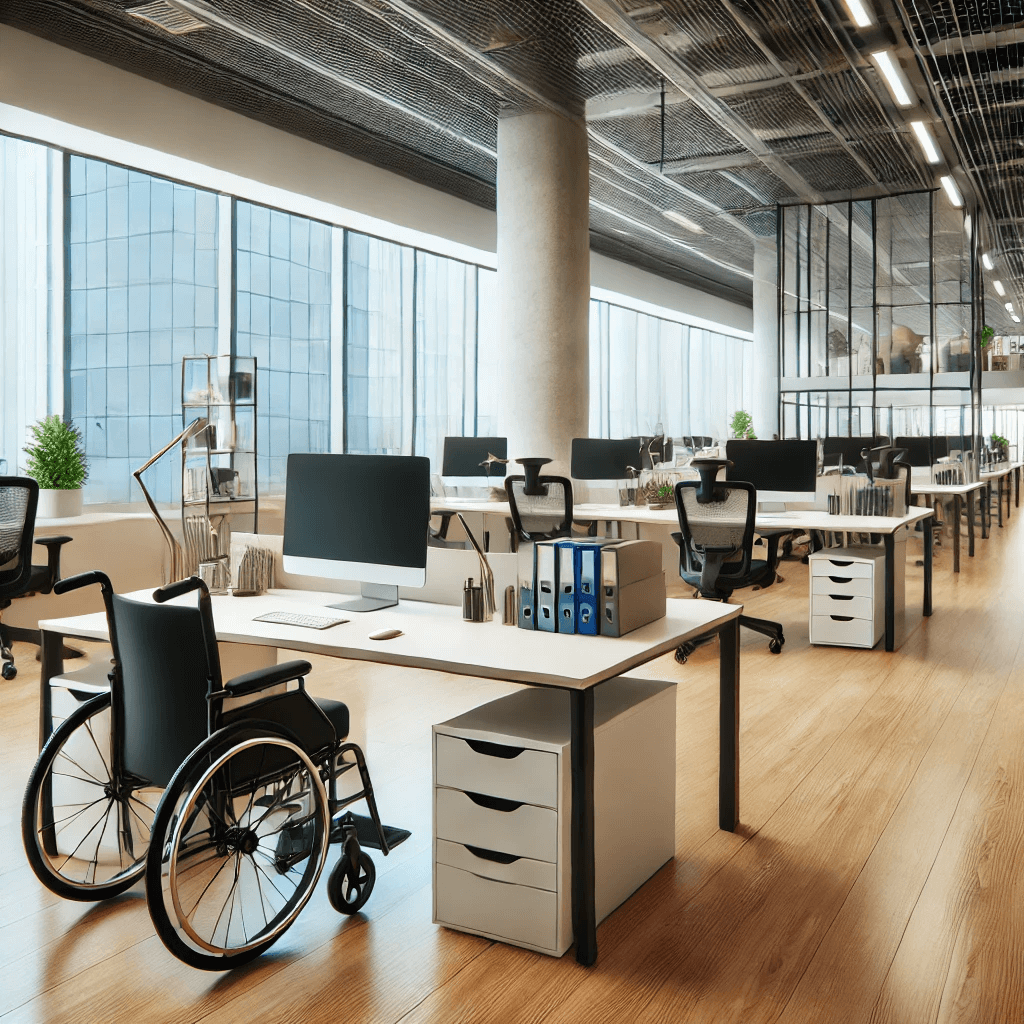Introduction
- Key Elements of an Accessible Workspace Design
- Understanding Accessibility Standards and Regulations
- Creating an Accessible Office Layout
- Entryways and Navigation
- Workstations and Desk Accessibility
- Restroom and Breakroom Accessibility
- Technology and Digital Accessibility
- Meeting Room and Conference Accessibility
- Emergency Preparedness for All Employees
- Inclusive Workplace Culture and Employee Support
- Budget-Friendly Accessibility Improvements
- Monitoring and Improving Accessibility Over Time
- Conclusion
- Questions:
Creating an accessible workspace design is essential for fostering a comfortable, inclusive, and productive work environment. A well-planned inclusive office design ensures that employees of all abilities can navigate and use office spaces safely and efficiently. Implementing workplace accessibility improvements, such as adjustable desks, accessible entryways, assistive technology, and ADA-compliant restrooms, helps businesses comply with accessibility laws while promoting equal opportunities for all employees. This guide covers key accessibility features that make workplaces more functional, inclusive, and welcoming for everyone.
Key Elements of an Accessible Workspace Design

Creating an accessible workspace design ensures that employees of all abilities can work comfortably and efficiently. A well-planned office should provide barrier-free navigation, ergonomic furniture, and assistive technology to accommodate diverse needs.
Key features of an accessible workspace design include wide, clutter-free pathways, adjustable desks and seating, accessible restrooms, and digital accessibility tools. Businesses that implement inclusive office design and workplace accessibility improvements not only meet ADA compliance but also create a more inclusive and productive work environment for all employees.
Understanding Accessibility Standards and Regulations
Key legal and industry standards include:
- ADA (Americans with Disabilities Act) – Requires businesses to provide reasonable accommodations for employees with disabilities.
- WCAG (Web Content Accessibility Guidelines) – Ensures websites and internal software are accessible to individuals with disabilities.
- ISO 21542 – International standard for building accessibility in workplaces.
Why Compliance Matters:
- Avoids legal issues and fines
- Increases employee retention and satisfaction
- Expand the talent pool by hiring diverse, skilled professionals
Creating an Accessible Office Layout
A well-designed layout ensures smooth movement for all employees.
- Wide, clutter-free pathways for easy wheelchair navigation.
- Adjustable desks and ergonomic furniture to accommodate different needs.
- Bright, adjustable lighting and high-contrast design for employees with visual impairments.
Entryways and Navigation
Ensure all employees and visitors can enter and move through the workspace easily.
- Install ramps and automatic doors for step-free access.
- Provide wide doorways and hallways (at least 32 inches wide).
- Use clear signage with braille and high contrast for individuals with vision impairments.
Workstations and Desk Accessibility
- Inclusive workstations improve comfort and efficiency for all employees.
- Adjustable height desks for wheelchair users and standing options.
- Ergonomic chairs and keyboard setups to prevent strain.
- Accessible storage spaces at comfortable reaching levels.
Restroom and Breakroom Accessibility
- ADA-compliant facilities ensure everyone has access to essential spaces.
- Grab bars and ample space for wheelchair accessibility.
- Lowered sinks, soap dispensers, and touchless paper towel holders.
- Breakroom tables and counters that accommodate all employees.
Technology and Digital Accessibility
- Make workplace technology inclusive for all users.
- Ensure company websites, training materials, and internal software meet accessibility standards.
- Provide screen readers, captions, and speech-to-text software for employees with hearing or visual impairments.
- Offer adjustable screen brightness and font size options.
Meeting Room and Conference Accessibility
- Inclusive meeting spaces ensure full participation.
- Adjustable seating and table height for diverse needs.
- Assistive listening devices and real-time captioning for hearing-impaired employees.
- Remote meeting options for accessibility and flexibility.
Emergency Preparedness for All Employees
- Develop an emergency plan that includes employees with disabilities.
- Accessible evacuation routes and exits.
- Emergency alarms with both sound and visual signals.
- Training staff on inclusive emergency response procedures.
Inclusive Workplace Culture and Employee Support
- A welcoming work environment extends beyond physical modifications.
- Disability awareness training for all employees.
- Encourage open discussions on workplace accessibility needs.
- Provide reasonable accommodations for employees with disabilities.
Budget-Friendly Accessibility Improvements
Creating an accessible workspace doesn’t have to be expensive. Many low-cost modifications can significantly improve workplace accessibility while ensuring compliance with regulations.
Low-Cost Modifications That Make a Big Impact
- Installing lever-style door handles for easier access.
- Use adjustable chairs and ergonomic accessories to accommodate different needs.
- Adding high-contrast signage and braille labels for better navigation.
- Rearranging furniture to create wider pathways for wheelchairs and mobility aids.
Government Grants and Financial Assistance for Accessibility Upgrades
- Many organizations offer grants and tax incentives for businesses implementing accessibility improvements.
- Programs like the ADA Small Business Tax Credit and local government grants help offset costs.
- Non-profits and disability advocacy groups may offer funding or consulting services for workplace modifications.
Prioritizing High-Impact Changes First
- Focus on critical accessibility needs such as entryways, restrooms, and workstations.
- Upgrade digital accessibility tools (e.g., screen readers, voice command systems) to support employees with visual or mobility impairments.
Monitoring and Improving Accessibility Over Time
- Accessibility should be continuously reviewed and improved.
- Conduct regular accessibility audits to identify areas for improvement.
- Seek employee feedback on workplace accessibility challenges.
- Stay updated on new technology and innovations in accessibility.
Conclusion
Implementing best practices for designing accessible workspaces creates a more inclusive, productive, and legally compliant workplace. Whether through physical modifications, assistive technology, or an inclusive company culture, accessibility improvements benefit everyone.
Questions:
What is accessible workspace design?
Accessible workspace design focuses on creating an inclusive office environment by incorporating barrier-free layouts, ergonomic furniture, and assistive technology to accommodate employees of all abilities.
What are the key features of an accessible workspace design?
Important elements include wide pathways, height-adjustable desks, accessible restrooms, automatic doors, and digital accessibility tools like screen readers and voice-controlled systems.
How can businesses improve workplace accessibility?
Businesses can implement workplace accessibility improvements such as installing ramps, using ergonomic office furniture, providing assistive technology, and training staff on inclusivity.
Why is an inclusive office design important?
An inclusive office design ensures that employees with disabilities can work comfortably, boosts productivity, improves compliance with ADA regulations, and fosters a diverse, welcoming workplace.
What are some budget-friendly accessibility upgrades for offices?
Affordable improvements include lever-style door handles, adjustable chairs, grab bars in restrooms, voice-activated assistants, and decluttering workspaces for easy navigation.














